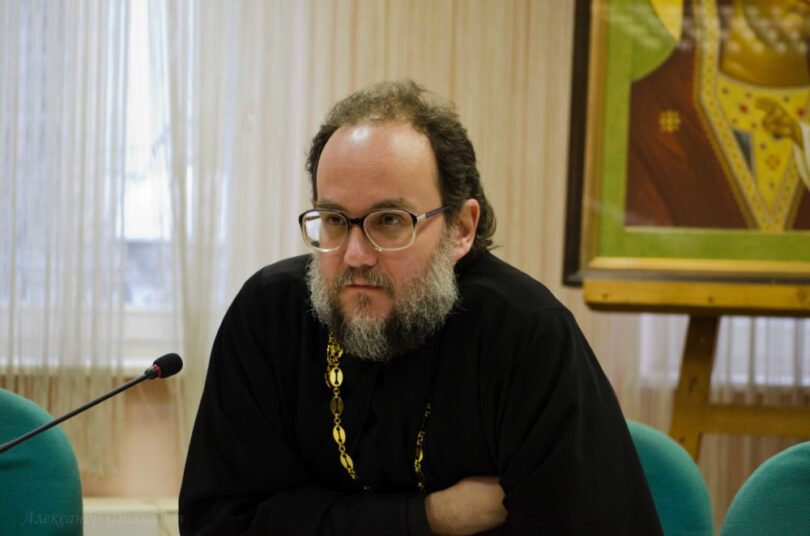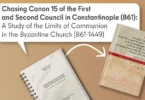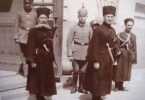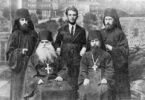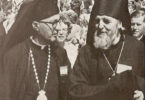Fr. Alexander, in your book The Supreme Hierarchs’ Opinions about Power Succession in the Russian Orthodox Church in 1920-30’s. [1] This book and other materials mentioned below were published in Russian; their titles are given here in English translation, except for periodicals, whose titles are given in Roman transliteration. you use the term “right wing opposition”. What exactly does it mean?
As the book itself explains, “The ‘right wing’ opposition to Metropolitan Sergius is understood as a quite widespread movement within the Church based not on its members’ monarchist preferences but on their disapproval of the Deputy Patriarchal Locum Tenens‘s church policy as initiated by OGPU [United State Political Administration, the state security body in the USSR, 1923-32]. The said Church opposition to the Deputy was termed as “right wing” soon after its advent; it seems to have happened in the circles sympathizing with Metropolitan Sergius… This designation should be considered conventional and not quite apt (since it seems to be borrowed from the political vocabulary of the Communist Party) yet it has taken root in the contemporary historiography of the Russian Church.”
The “right wing” church opposition is a movement of Church zealots and non-conformists as opposed to “left wing” schisms whose main raison d’être was an attempt to adapt themselves to the theomachistic Bolshevist power. In addition, there were significant differences between the statuses of “the left” and “the right” in canonical terms. “The left” (“obnovlentsy” [Renovationists] and such) had acted in line with the Bolshevist policy and gone as far as the creation of parallel pseudo-ecclesiastical structures, that is to say, effected an obvious schism in the Church, whereas “the right wing” church opposition had stressed their loyalty to the priest-martyr, Metropolitan Peter (Polyansky), the Patriarchal Locum Tenens and the head of the Russian Church of the time; they, being represented by their leaders such as the priest-martyr, Metropolitan Cyril (Smirnov) indeed had been like-minded with him as far as the main issues of the church life was concerned (in particular, in their views of the scope of the Deputy Locum Tenens ‘s power).
Fr. Alexander, what reasons had led the bishops, clergy, and laity alike to the severing of ecclesiastical communion with Metropolitan Sergius (Stragorodsky, †1944)?
The main reason, as I said, was their disapproval of the Deputy Patriarchal Locum Tenens‘s church policy that was forced on him by the powers that be and was aimed at subjecting the Church’s internal life to full control by the theomachistic Bolshevist authorities. In practical terms it meant that bishoprics were offered on the condition that the bishops would first get in touch with OGPU and then follow the agency’s secret instructions. Of course, not everybody’s conscience permitted them to accept such conditions. Some expressed their protest by retiring silently. Others, seeing what the so-called “legalization” turns out to be for the Church, had found it necessary to declare their dissent openly. Many were sickened by the obvious falsehood that had been voiced since 1927 on behalf of Metropolitan Sergius; they regarded as intolerable the drawing of the Church into politics on the side of Bolshevists, which in fact meant that the confessors persecuted by the theomachists were declared political criminals. More detailed discussion of this subject is presented in my work Reasons for the Disapproval of Metropolitan Sergius (Stragorodsky)’s Policies by the Ecclesiastical Circles (after Polemical Publications of the late 1920’s and 1930’s. Its findings could be summarized as follows:
The requirement of the Church’s civic loyalty to the authorities per se was not inacceptable for the majority of those in opposition to Metropolitan Sergius. Even the Russian émigré clergy who harbored the most antagonistic feelings for Bolshevism were appreciative towards Moscow ecclesiastical authorities’ attempts to normalize their relations with the Soviet state that had taken place up till 1927.
The course taken by Metropolitan Sergius since 1927 seemed to his opponents to express his willingness, not only to submit to the state authorities, but even to serve them. The most radically minded members of the opposition accused the Deputy of taking the side of the theomachists and of quite consciously participating in the destruction of the Church.
Even those of Metropolitan Sergius’s opponents who did not consider his actions as definitely collaborationist saw in them a deviation from the apolitical line of action previously taken by the Patriarch and Locum Tenens. Metropolitan Sergius quite obviously was drawing the Church into politics on the side of the Soviet power; political opponents to Bolshevism were proclaimed enemies of the Church.
The doubts in Metropolitan Sergius’s competence to change the character of the Church-state relations were enforced by his challengeable position as Deputy Patriarchal Locum Tenens in the absence of permission for changing the course from either Locum Tenens himself or the episcopate and the Church in its catholic fullness. The accusations of canonical defectiveness of Metropolitan Sergius’s ruling were enforced by his being under suspicion of willingness to please the authorities and abolish the Patriarchal order in the Russian Orthodox Church in favor of the synodical one.
How many bishops within the USSR had severed their ecclesiastical communion with Metropolitan Sergius by the time of World War II and what was their percentage in the whole of the ROC’s episcopate?
According to my estimates, more than forty Orthodox bishops in Russia (within the USSR) had found themselves in opposition to Metropolitan Sergius which was manifested in various forms. The total number of bishops at the time was about two hundred (not including those abroad). In his “interview” to foreign reporters published in February of 1930 Metropolitan Sergius claims that 163 bishops were canonically subordinated to the Moscow Patriarchate (that number seems to have included also some Russian bishops abroad, such as Metropolitan Eulogius and his vicars, who soon after that freed themselves from Moscow jurisdiction). Therefore, it can safely be said that no less than a quarter of the Russian episcopate had explicitly expressed their disagreement with the Deputy’s politics. In addition, it is important to consider not only the quantitative but also qualitative aspects of the matter in question: suffice it to point out that all three candidates that Patriarch Tikhon selected for the position of Locum Tenens were among the dissentients, namely, Metropolitans Cyril (Smirnov), Agafangel (Preobrazhensky), and Peter (Polyansky) – the latter came to lead the Russian Church after the decease of the Patriarch Saint.
What ecclesiastical approaches towards Metropolitan Sergius had been practiced by the bishops who had severed communion with him?
All kinds of approaches. The extreme position might probably be considered the one held by the priest-confessor, Bishop Victor (Ostrovidov). His, for example, is the following statement: “Being as he is in all his activities an anti-Church heretic who turns the Holy Orthodox Church from the house of salvation full of divine grace into a carnal organization devoid of divine grace and of the spirit of life, Metropolitan Sergius, in his conscious renunciation of truth and his insane betrayal of Christ, is at the same time a manifest apostate of the God of Truth” (Acts of His Holiness Tikhon, the Patriarch of Moscow and All Russia; the Most Recent Documents and Correspondence Regarding Canonical Succession of the Supreme Ecclesiastical Power, 1917-43, compiled by M. Ye. Gubonin, Moscow, PSTGU[iii] Publishers, 1994, p. 635). It is worth noting that such views of Bishop Victor’s, which he never concealed, did not hinder his eventual canonization by both the Church outside Russia and the Moscow Patriarchate. More sober position towards Metropolitan Sergius was held by the priest-martyr, Metropolitan Cyril (Smirnov). He wrote, “I regard the abstaining from communion with Metropolitan Sergius and the like-minded bishops as a fulfillment of my duty as an archpastor. By this abstinence of mine, I by no means allege or suspect a supposed absence of grace in the service rituals and sacraments performed by the Sergians (may the Lord keep us all from such thoughts) but only stress my unwillingness and refusal to partake of somebody else’s sins. Therefore, I will not co-celebrate liturgy with Metropolitan Sergius or like-minded bishops, but in case of deadly peril will with a quiet conscience accept the last sacrament and parting words from a priest of Sergius’s appointment or one subordinated to his Synod, if there could be found no priest sharing my attitude towards Metropolitan Sergius and so called Provisional Patriarchal Synod” (ibid, p. 640). At the same time, the priest-martyr Cyril entertained warm feelings for the priest-confessor Victor even though he was aware of the latter’s extreme views of Metropolitan Sergius.
How strong were monarchist sentiments among the members of “right wing opposition”?
Two quotations presented in my book partially answer this question. Thus, Metropolitan Joseph (Petrovykh) while being interrogated in 1930 declared, “I’ve never been a supporter of the old regime with which I have had, because of it, considerable misapprehensions (after I ceased in 1905 any remembrance of the Czar’s family during the Church service I was temporarily deprived of the right of divine service, transferred to a worse position, deprived of bonuses and promotion, etc.” A prominent Moscow “Josephite” (who later came to peace with the Deputy), Archpriest Valentine Sventitsky when defining his attitude towards monarchy went even further. During his interrogation in 1928, he declared, “I myself am a foe to the Czarist power and consider the Soviet power the most appropriate system of government except its atheistic nature.” Of course, we must take into consideration the circumstances in which such declarations were made, but what is known of V. P. Sventitsky’s pre-Revolution biography portraits him as a convinced enemy of monarchy. Even more expressive picture might present itself if we look at how some of the future Metropolitan Sergius’s opponents reacted to the 1917’s collapse of monarchy in Russia. Even though there certainly were among the members of the “right wing” Church opposition convinced monarchists, too, but they cannot be regarded as a majority.
What significance had the stance of the Russian Church outside Russia for the “right wing opposition”?
On September 9, 1927, the Episcopal Council of the Russian Orthodox Church Outside Russia issued an encyclical in which it publicly announced that “the foreign part of the All-Russian Church must sever administrative relations with the Moscow ecclesiastic authorities … because of the latter’s enslavement by the ungodly Soviet power.” However, the Council goes on to claim, “The foreign part of the Russian Church considers itself an inseparable and spiritually integral branch of the Great Russian Church. It does not separate itself from its Mother Church or consider itself autocephalous. It keeps on regarding as its head the Patriarchal Locum Tenens, Metropolitan Peter, and exalting his name at the divine services.” (Tserkovnye vedomosti, 1927, No. 17-18, p. 3). The decision, however, of Metropolitan Sergius and his Synod, dated May 9, 1928, characterized the September encyclical of the foreign Council as “quite obviously serving as an action program for a certain part of renegades inside the USSR also.” (Tserkovny vestnik Zapadno-Evropeyskoy eparkhii, 1928, No. 12, p. 3). And shortly, indeed, the path foreordained by the foreign bishops, the one of separating from the Deputy while preserving spiritual ties with the Locum Tenens, was taken by dozens of the motherland bishops, many with their flocks. However, they were not “renegades” as characterized by the Metropolitan of Nizhny Novgorod but the best members of the Russian Orthodox Church, many of whom have since been glorified in the Community of Saints.
What has the “right wing opposition” conferred on the Russian Orthodox Church?
Let me answer in brief with a quotation from the preface to our new book, “Those who Thirst after Righteousness”: “The ecclesiastical opposition’s most vigorous defense against the policy of indulgence has helped preserve the Russian bishops’ honor. The best among those had chosen the road to Calvary and martyrdom for Christ, whose feat has eventually secured the victory over the persecutors.” (“Those who Thirst after Righteousness”: Material on the Ecclesiastical Controversy of 1927. Managing Editor Archptiest V. Vorobyov, compilers and authors of the introductory article priest A. Mazyrin and O. V. Kosik. Moscow, PSTGU Publishers, 2010, p. 6).
How would you evaluate the Russian Church outside Russia’s attitude towards the Church inside Russia? Was it in harmony or in disharmony with the motherland Church?
The Church in Russia as represented by Patriarch Tikhon, the Patriarchal Locum Tenens, Metropolitan Peter, and, at first, by his Deputy, Metropolitan Sergius (during the early period of his deputyship) had firmly taken the stance of non-interference into political struggle. On July 1, 1923, St. Tikhon wrote, “The Russian Orthodox Church is apolitical and has no desire to be either “white” or “red” Church. It must and will be one, holy, catholic, and apostolic Church, and all and any attempts, whosever side may they originate from, to plunge the Church into political struggle must be rejected and condemned.” (Acts of His Holiness Tikhon, p. 164). The stance of the Church Abroad as regards not being “white” quite obviously differed from that of the Patriarch. Yet his unwillingness to make the Church in Russia “red” was duly appreciated by the Russians abroad. In addition, Patriarch Tikhon, Metropolitan Peter, and (in 1926) Metropolitan Sergius all had been doing their best to avoid punitive functions against the Church Abroad that they had been forced to apply. In the draft of his declaration of 1926, Metropolitan Sergius unequivocally stated that “to attack the clergy abroad with some ecclesiastical punishments for their unfaithfulness to the Soviet Union would be absurd and would only create yet another excuse for blaming us for being forced to do so by the Soviet power.” (Acts…, p. 474). This stance of the Moscow ecclesiastical authorities was appreciated among the Russians abroad. Up till 1927, rapport between the Churches in the Motherland and abroad might be said to generally persist. The thing is, for some the preservation of such rapport was part of their exploits as confessors and soon made them victims of persecution by the authorities (not everybody, for example, knows that the main reason for the Patriarchal Locum Tenens, Metropolitan Peter’s arrest in 1925 was his refusal to fire Metropolitan Anthony (Khrapovitsky) from the Kiev diocese which he then still kept on heading, albeit pro forma). Others, though, were content just to pay the Russian confessors lip service by claiming solidarity with them, while the question remains whether they themselves were confessors in spirit. Thus, the actions of the head of the Western European Diocese of the ROCOR, the Most Eminent Seraphim (Lukianov) demonstrate that not every bishop broad was a confessor. In 1930, he declaimed that Metropolitan Sergius “is a theomachist; not only did he break away from the Church but is fighting against it” (Tserkovnye vedomosti, 1930, No. 15-16, p. 7). Yet when he himself in 1945 got caught into the Soviet secret services’ sphere of action in France (not in the USSR) he hurriedly took a pro-Soviet stance.
Interview by Deacon Andrei Psarev
References
| ↵1 | This book and other materials mentioned below were published in Russian; their titles are given here in English translation, except for periodicals, whose titles are given in Roman transliteration. |
|---|

